The best foldable phones: top tablet and flip foldables from Samsung, Google, and more
Our ranking of the best foldables, based on real world testing
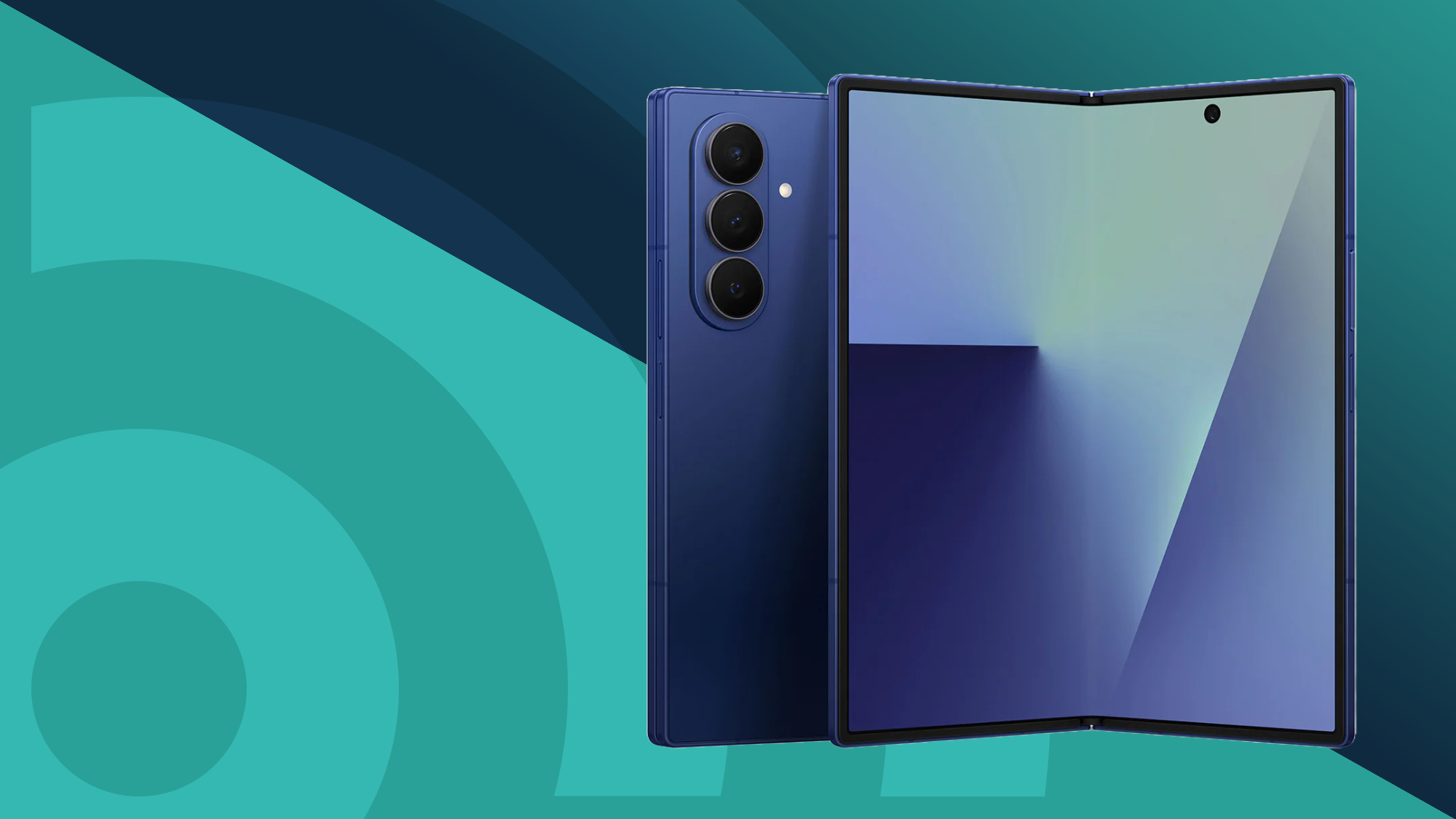
The best folding phones elevate the smartphone experience by offering two unique ways to use your device – folded and unfolded – and here at TechRadar we've reviewed all the best devices in this cutting-edge category, from pocketable flip phones to powerful tablet-style foldables.
Samsung still leads the way when it comes to folding phones. The tech giant recently brought major upgrades to the world's most popular folding phones with the Galaxy Z Fold 7 and Galaxy Z Flip 7, both of which impressed us during testing with their sleek new designs and expanded cover screen functionality. Both handsets appear on our list as the best folding phone overall and the best flip phone.
Samsung's main rival when it comes to folding phones is Google, which recently released the Google Pixel 10 Pro Fold. The newest Pixel folding phone adds support for PixelSnap magnetic accessories and an IP68 rating for dust and water resistance – in fact, it's the first folding phone to do so. We continue to see inventive new folding phones from other phone makers, too, and you'll find models from Motorola, OnePlus, and Oppo on our list.
There's plenty to look forward to in the world of folding phones, too. After months of rumors, Samsung has officially announced the Galaxy Z Trifold, the first tri-fold phone to come to the US. And whispers of a foldable iPhone are still circulating, despite a lack of word from Apple about the long-rumored handset.
So, if you're looking for a new folding phone, the handsets listed below are the best you can get – but if you want something a little more conventional, be sure to check out our lists of the best phones and best Android phones.
The best foldable phones
Here are our top picks for the best foldable, the best flip phone, and the best choice for folks looking for a bargain
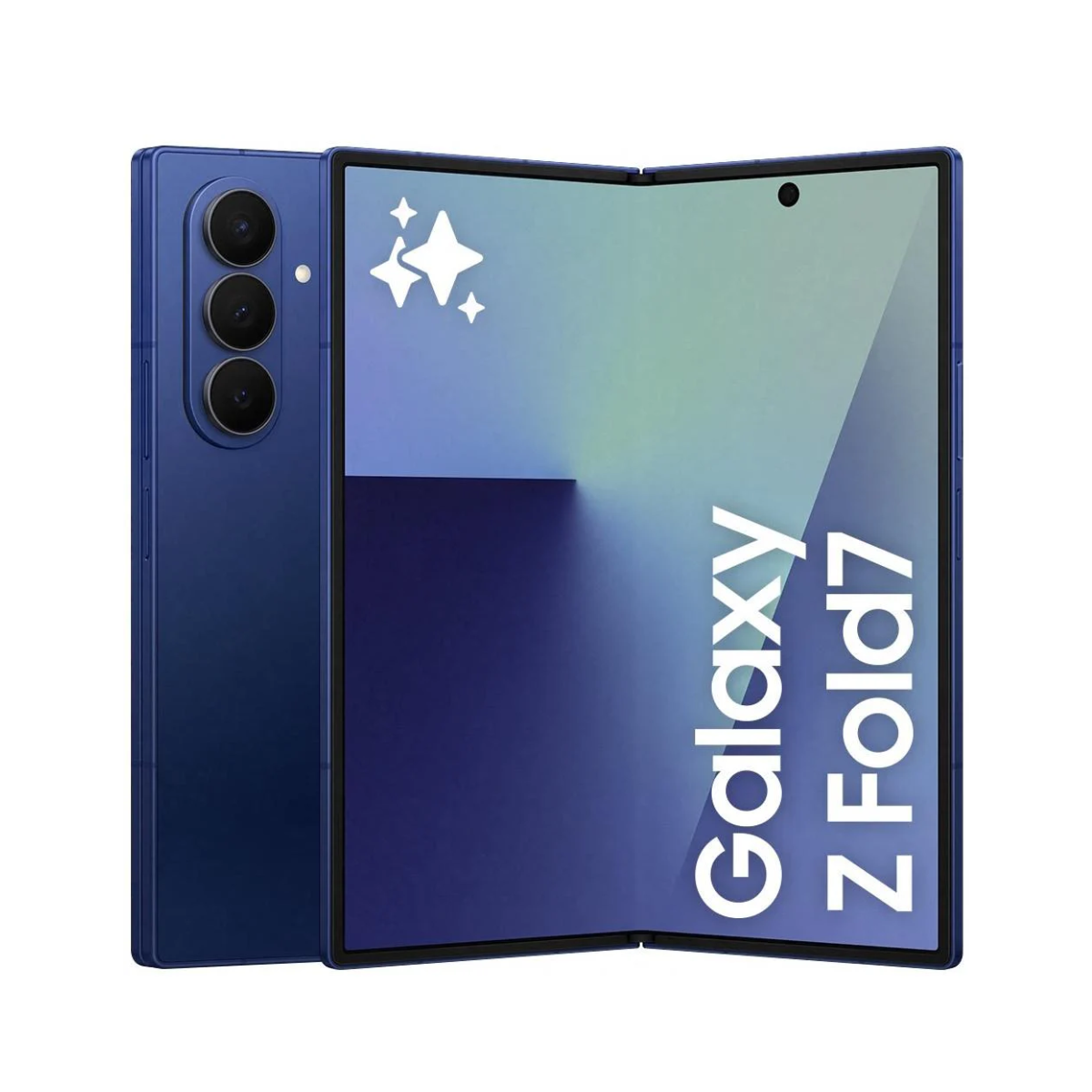
The Samsung Galaxy Z Fold 7 sets a new standard for tablet-style folding devices. It's got beautiful, wider displays, a truly flagship camera system, and class-leading internals. Samsung has also slimmed the Galaxy Z Fold 7 down to an impressive 4.1mm when unfolded – the only downside is the high price.

The Google Pixel 10 Pro Fold is the only folding phone on the market with an IP68 rating against dust and water, so it's the folding phone of choice for those who want the best protection against the elements. It's also a superbly capable folding phone in its own right thanks to Google's great software.
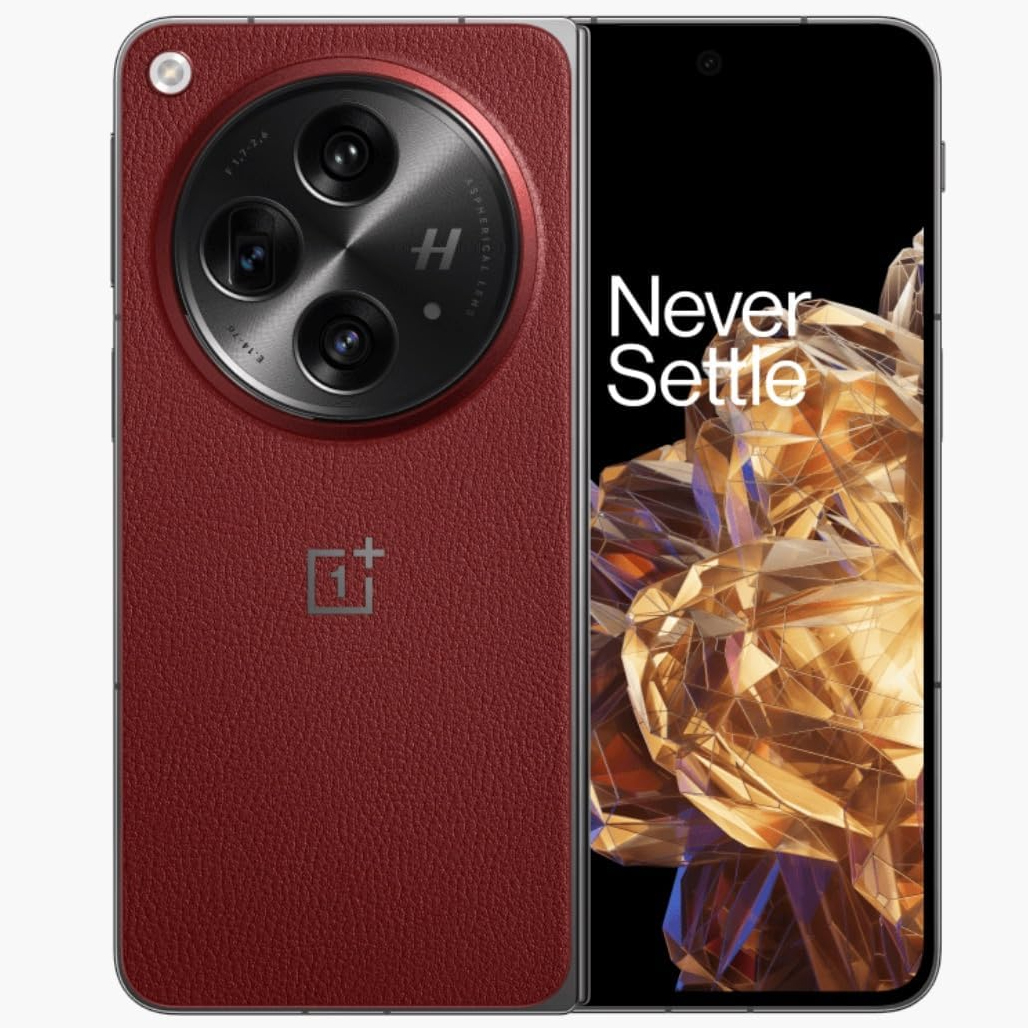
The OnePlus Open was the most affordable foldable phone when it launched in October 2023, and now it costs even less while still holding its own. If you can afford it, the new Apex Edition in Crimson is one of the prettiest phones we've ever seen.
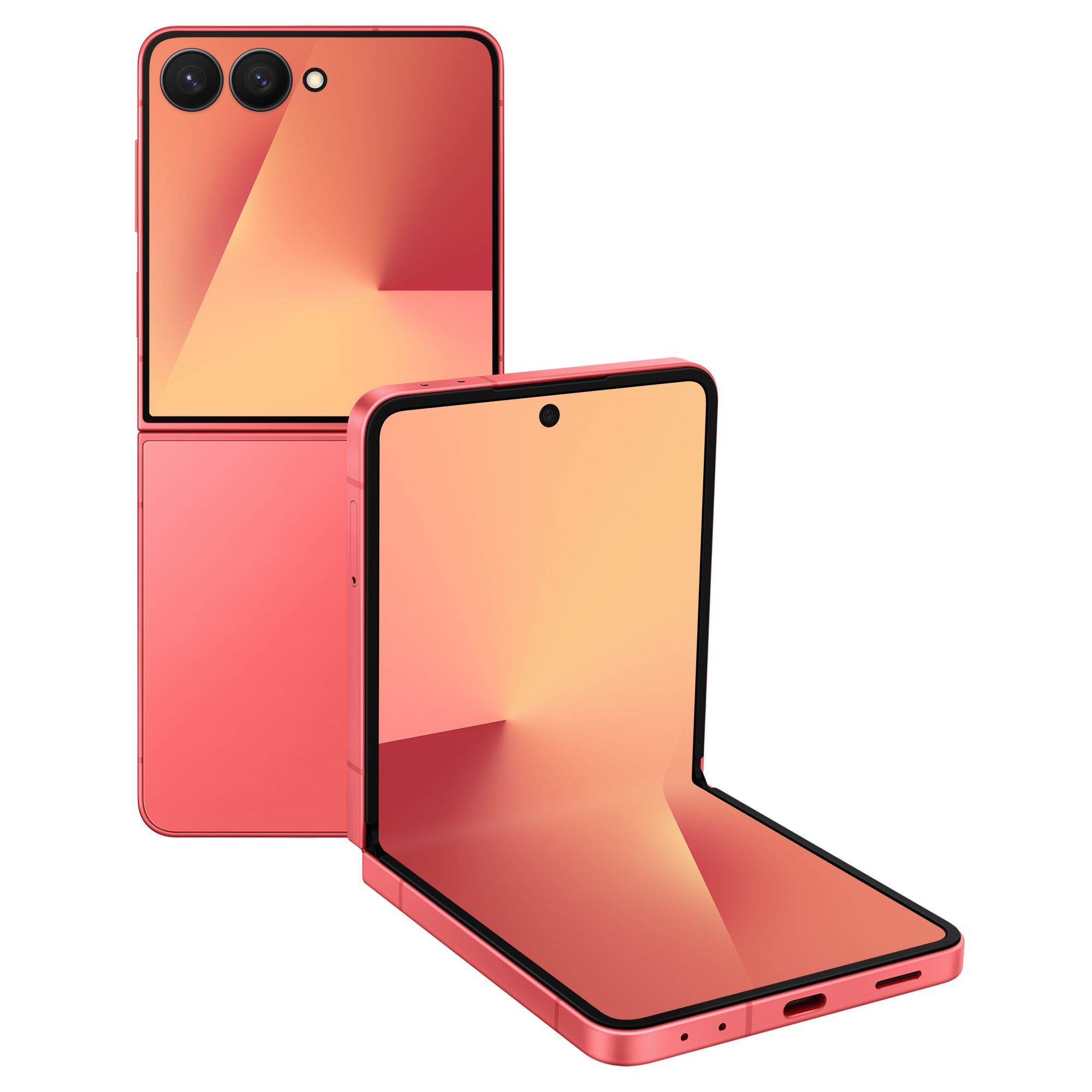
The Galaxy Z Flip 7 is the best flip phone Samsung has ever made, and our pick for the best on the market – its 4.1-inch cover display is finally edge-to-edge, wrapping around the dual camera system. Inside, the 6.9-inch main display remains as beautiful to look at as it is easy to use.
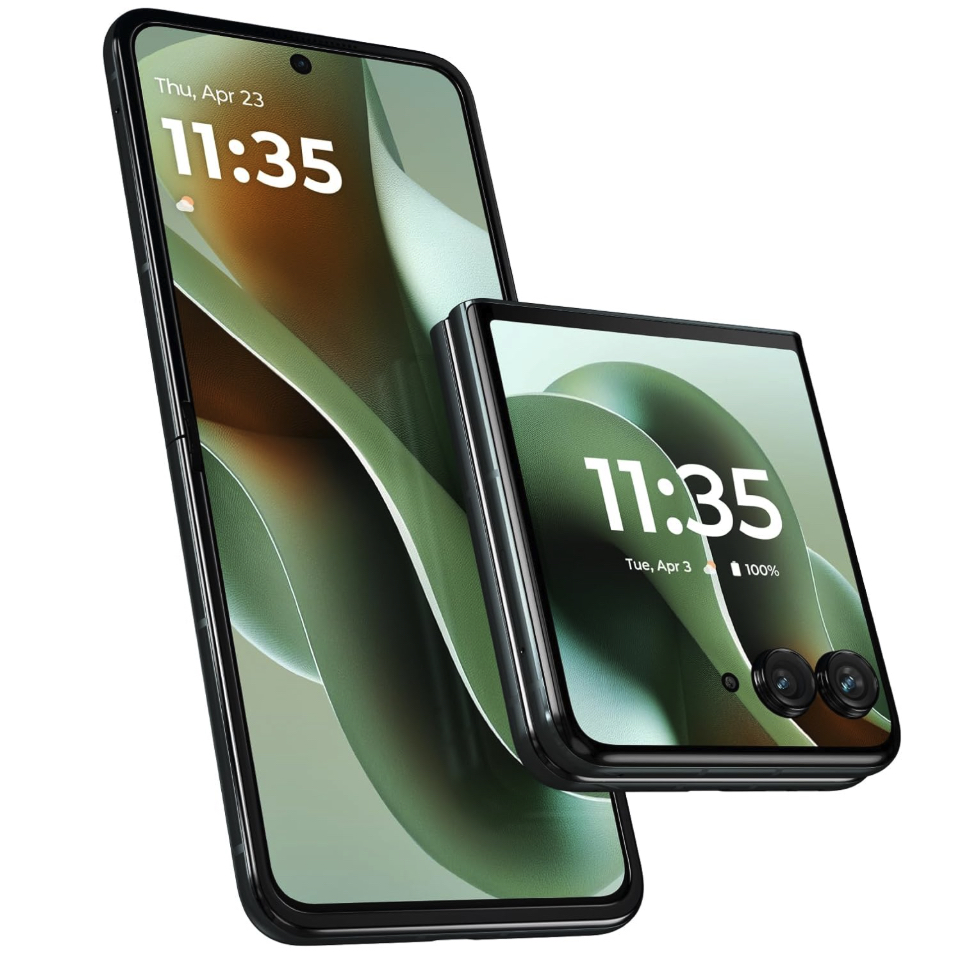
Motorola has continued its hot streak by releasing another sleek and stylish flagship, the Motorola Razr Ultra 2025. As well as a 165hz 4-inch cover screen and beautiful 6.9-inch folding display, the Razr Ultra 2025 comes in a variety of gorgeous finishes, including a unique wood-panel effect.

Though incredibly hard to get a hold of in most Western markets, the Oppo Find N5 has found its way onto our list thanks to its forward-thinking design, immense hardware power, and slim build. It's the folding phone of the future, just don't bank on being able to buy one (unless you're in Australia).
Read more below

As TechRadar's Mobile Computing Staff Writer, I write about all the latest folding phones and the technology that powers them. I previously used the OnePlus Open as my daily driver and have tested other folding devices including the Honor Magic V5, Oppo Find N5, and Xiaomi Mix Flip, so I know what makes a great folding phone experience.
The best folding phone in 2025
Why you can trust TechRadar
Here you'll find write-ups and specs for each of the best folding phones that appear in our list. We've tested each of these models and published full reviews, so you know our list is based on real-world use and expert experience.
The best foldable phone

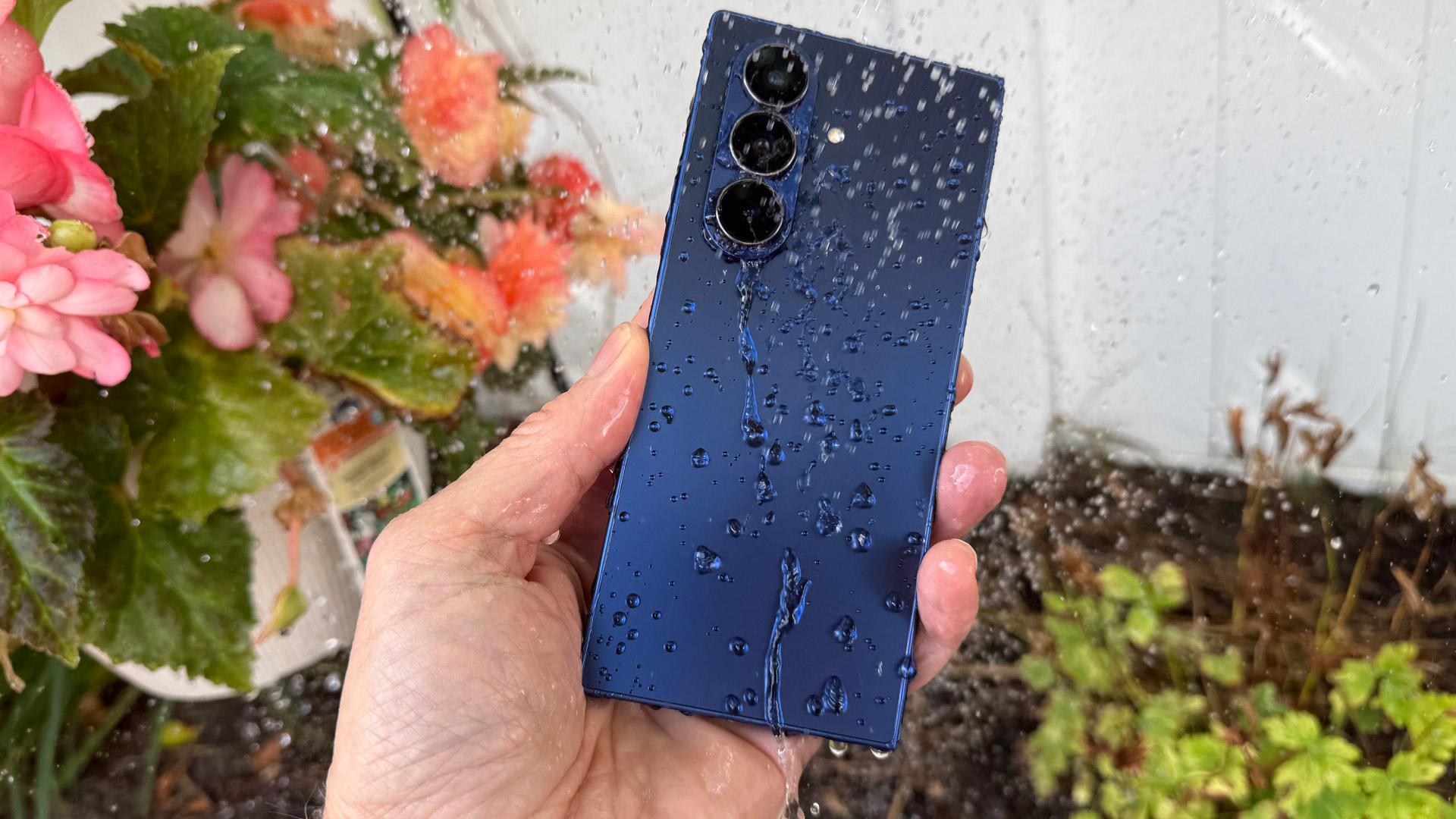
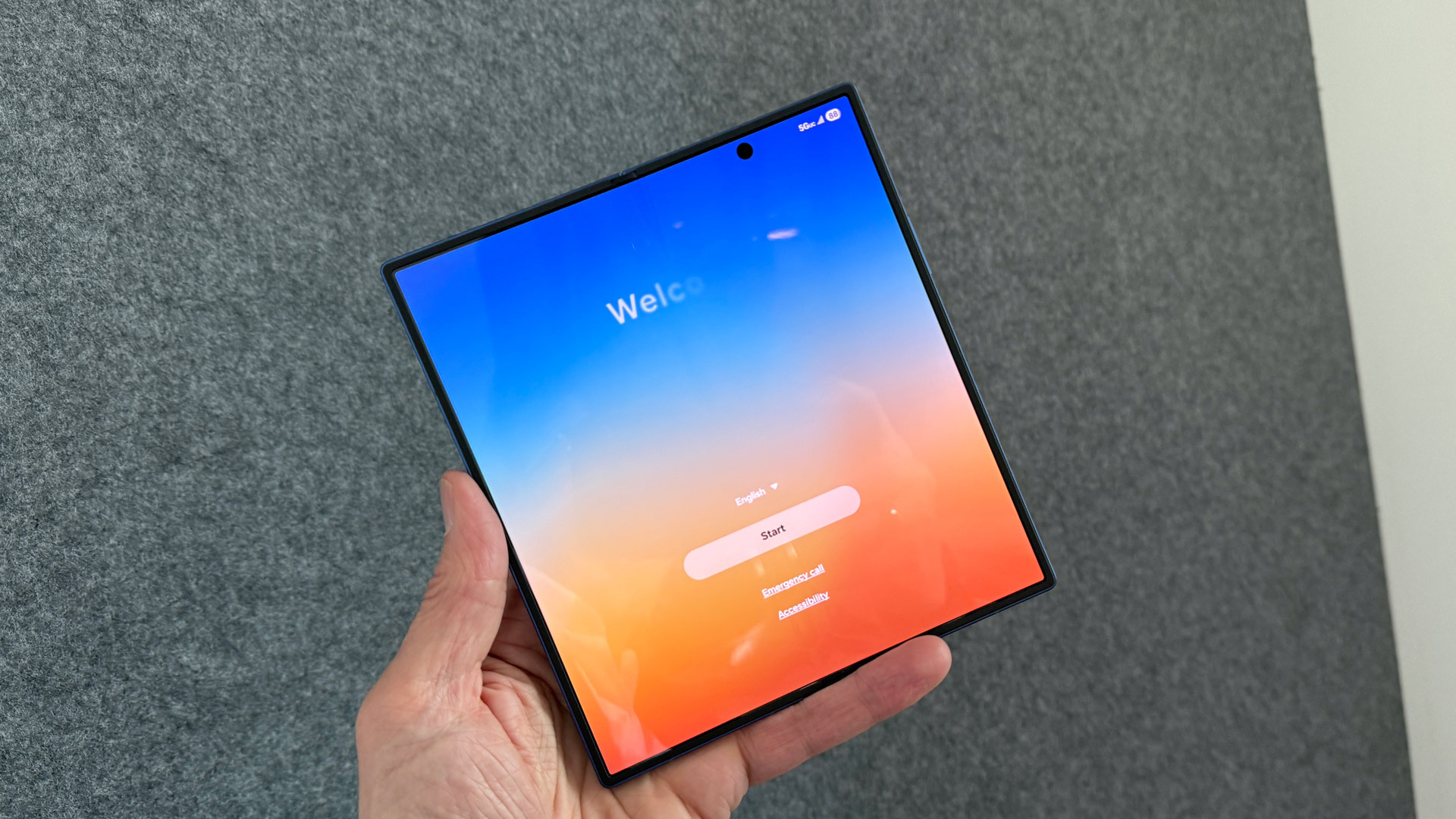

1. Samsung Galaxy Z Fold 7
Our expert review:
Specifications
Reasons to buy
Reasons to avoid
The Samsung Galaxy Z Fold 7 takes the world's most popular booklet-style folding phone to new heights. After a few years of iterative upgrades, Samsung really pulled out all the stops with the Galaxy Z Fold 7: bigger displays, more hardware power, and a new thin and light design that blew us away during review testing.
Let's start with the screens: the Galaxy Z Fold 7 is physically taller and wider than its predecessor, which means both of its displays have been made a bit larger. Its cover display is now a 6.5-inch panel in a more useable 21:9 aspect ratio, while the main display now measures 8 inches diagonally. Both displays are as sharp and bright as you'd expect,
The Samsung Galaxy Z Fold 7 is also the first folding phone to sport a truly flagship-class camera system. Its 200MP main camera has the same ultra-high resolution sensor as the Galaxy S25 Ultra and Galaxy S25 Edge, and it also packs a telephoto and ultra-wide camera for flexibility. As our sample photos in the review linked below demonstrate, no other folding phone comes close.
Underneath those beautiful displays, the Samsung Galaxy Z Fold 7 is powered by the Qualcomm Snapdragon 8 Elite for Galaxy chipset, the best chipset for Android phones. It also has 12GB or 16GB of RAM, depending on configuration, and 256GB, 512GB, or 1TB of storage. The only drawback is the price – the Galaxy Z Fold 7 starts at a hefty $1,999.99 / £1,799 / AU$2,899.
Read our full Samsung Galaxy Z Fold 7 review
The most durable foldable phone
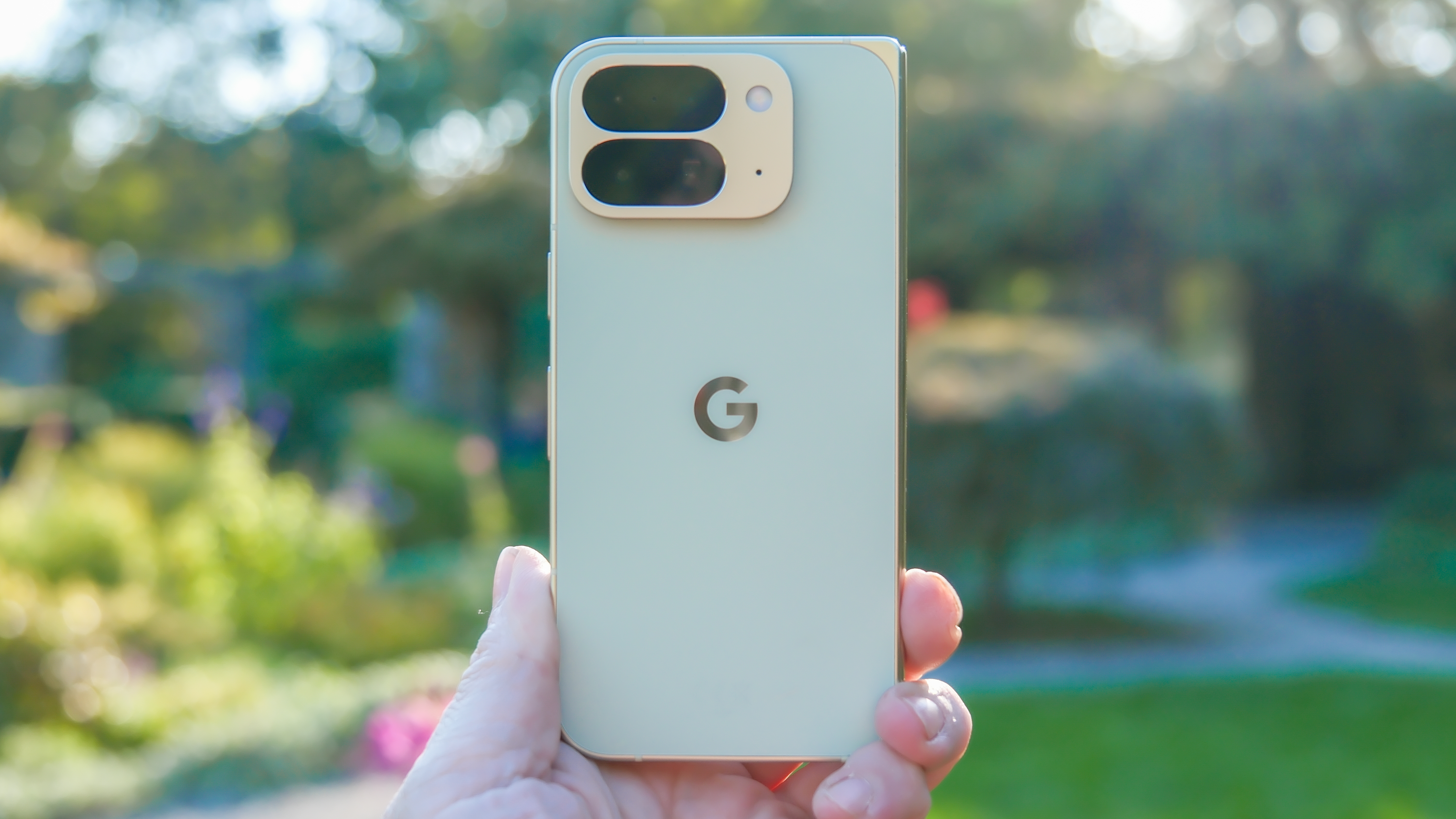
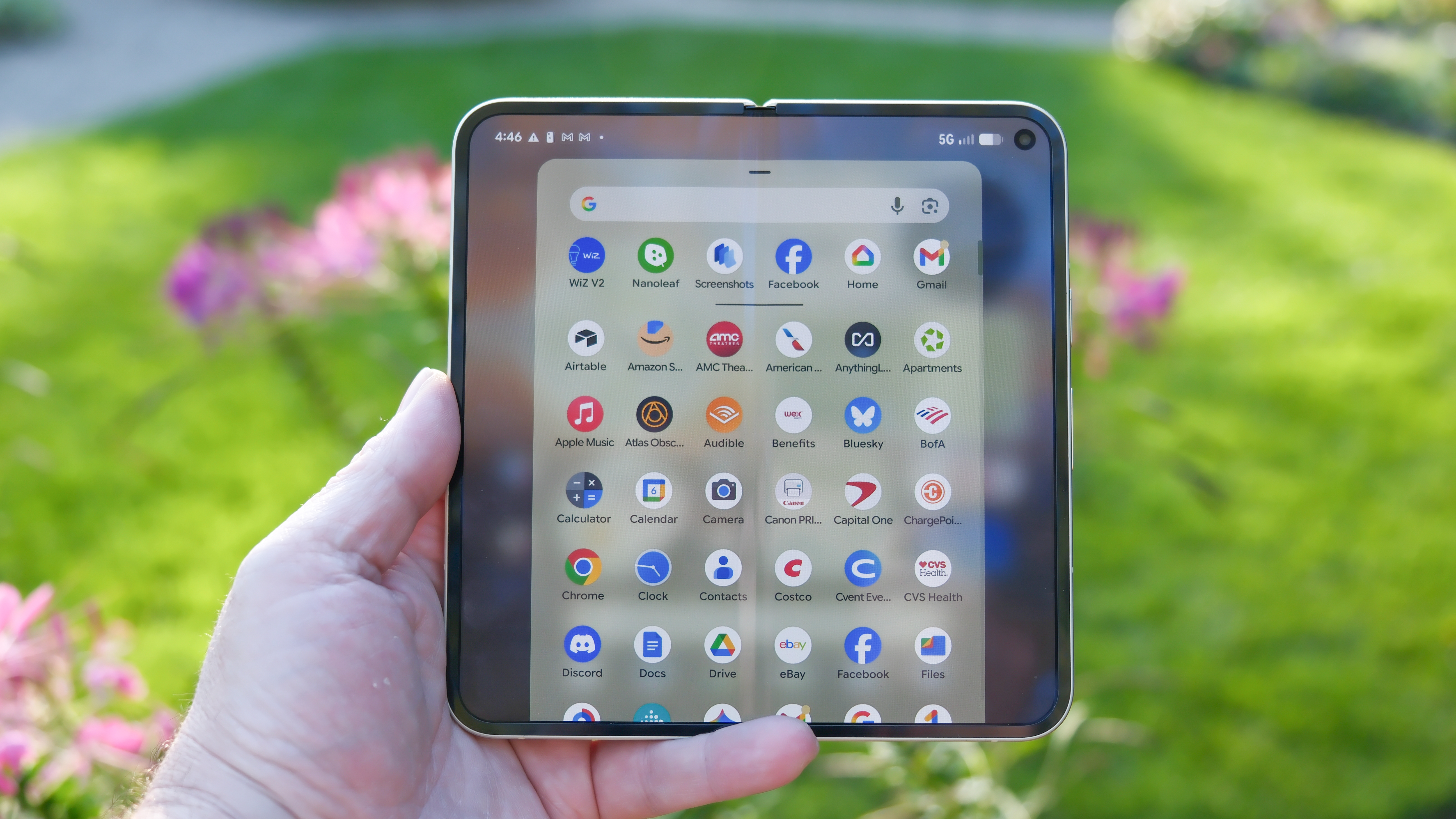
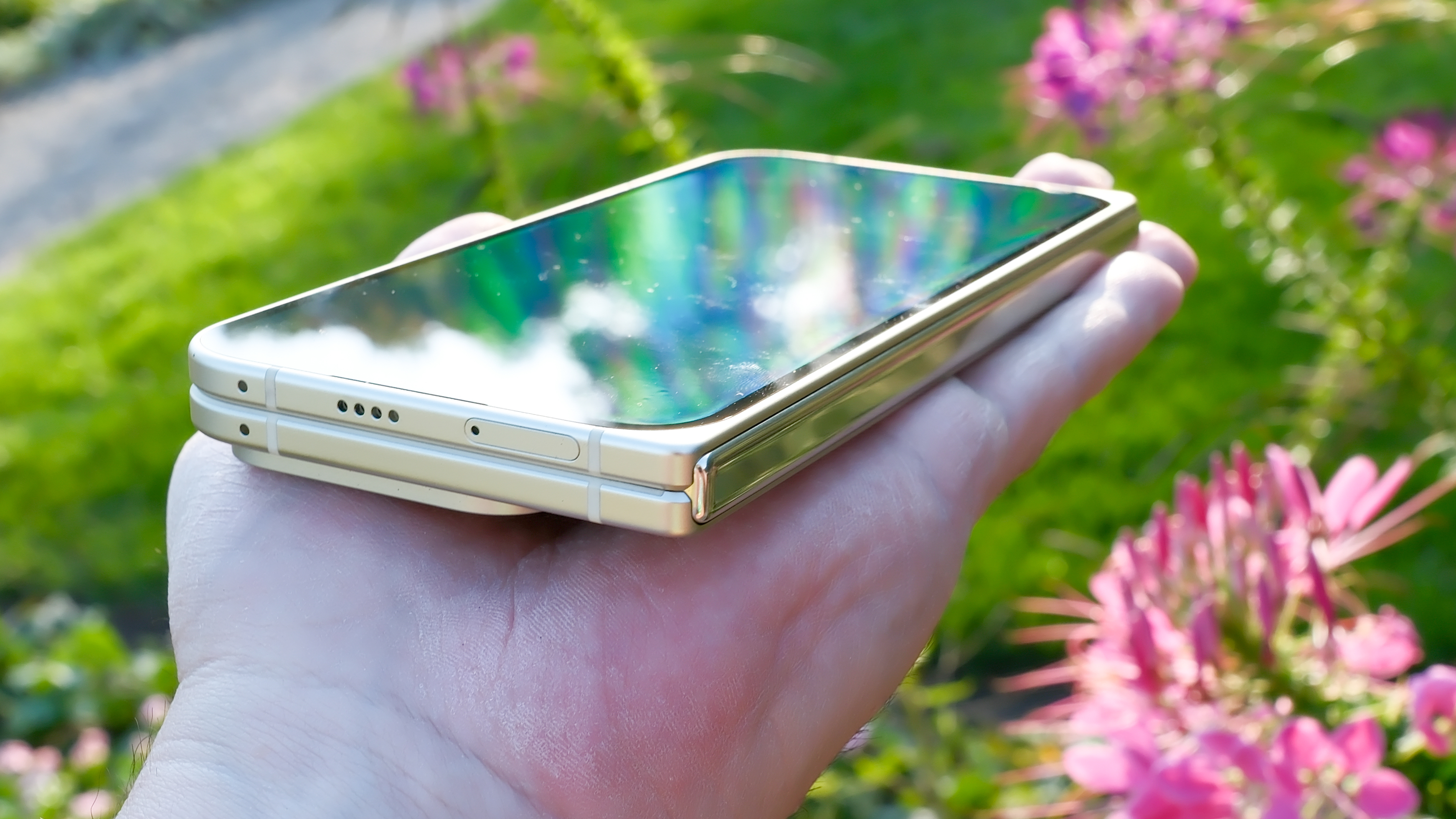
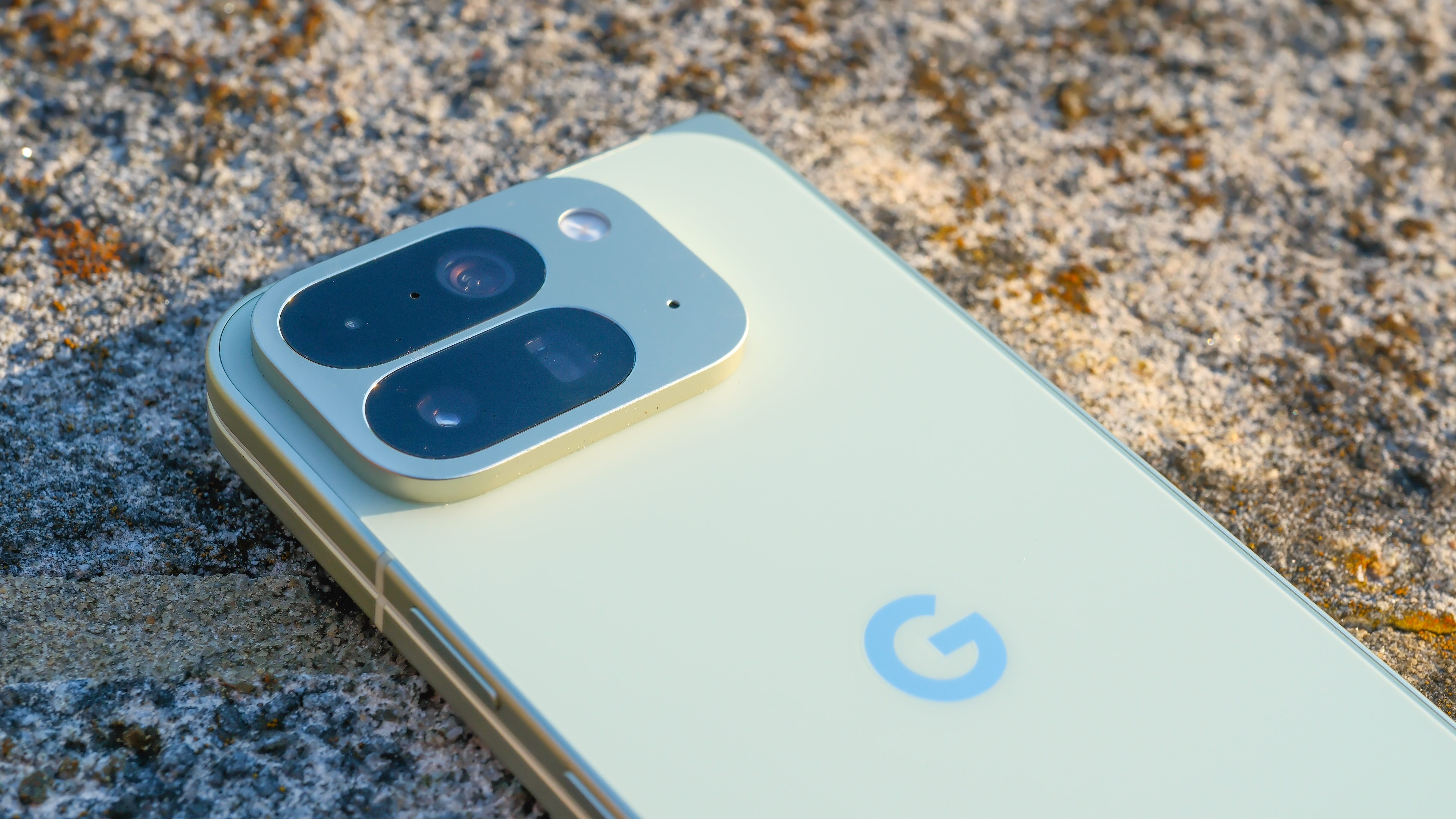
Specifications
Reasons to buy
Reasons to avoid
The Google Pixel 10 Pro Fold is the first folding phone with an IP68 rating against dust and water ingress. That means that it's practically dust-sealed and submersible in up to 1.5m of fresh water, giving you better protection against the elements than any other folding phone. While other models from Samsung and Honor offer submersion resistance, no other folding phone can offer the Google Pixel 10 Pro Fold's level of protection against dust.
While folding phones are by their nature more complex and a bit more fragile than slab phones, the Google Pixel 10 Pro Fold is the easy choice for those who want extra peace of mind when it comes to resisting the elements. With most mid-range and high-end slab phones offering this kind of protection, it's something worth considering if you're looking to switch to a folding phone.
The Google Pixel 10 Pro Fold is also a solid phone in its own right. In testing for our Pixel 10 Pro Fold review, we found that Google's latest folding phone offers great software, useful magnetic charging via the PixelSnap system, and fantastic displays that mirror the brilliant screens on the mainline Pixel 10 series.
And while the Galaxy Z Fold 7 is a better overall package, the Google Pixel 10 Pro Fold still offers some key benefits over its Samsung rival, such as a larger battery, access to Android beta features, and a longer-range 5x telephoto camera. It's the foldable of choice for Pixel fans and a quirky adversary to Samsung's class leader.
Read our full Google Pixel 10 Pro Fold review.
The best bargain foldable phone

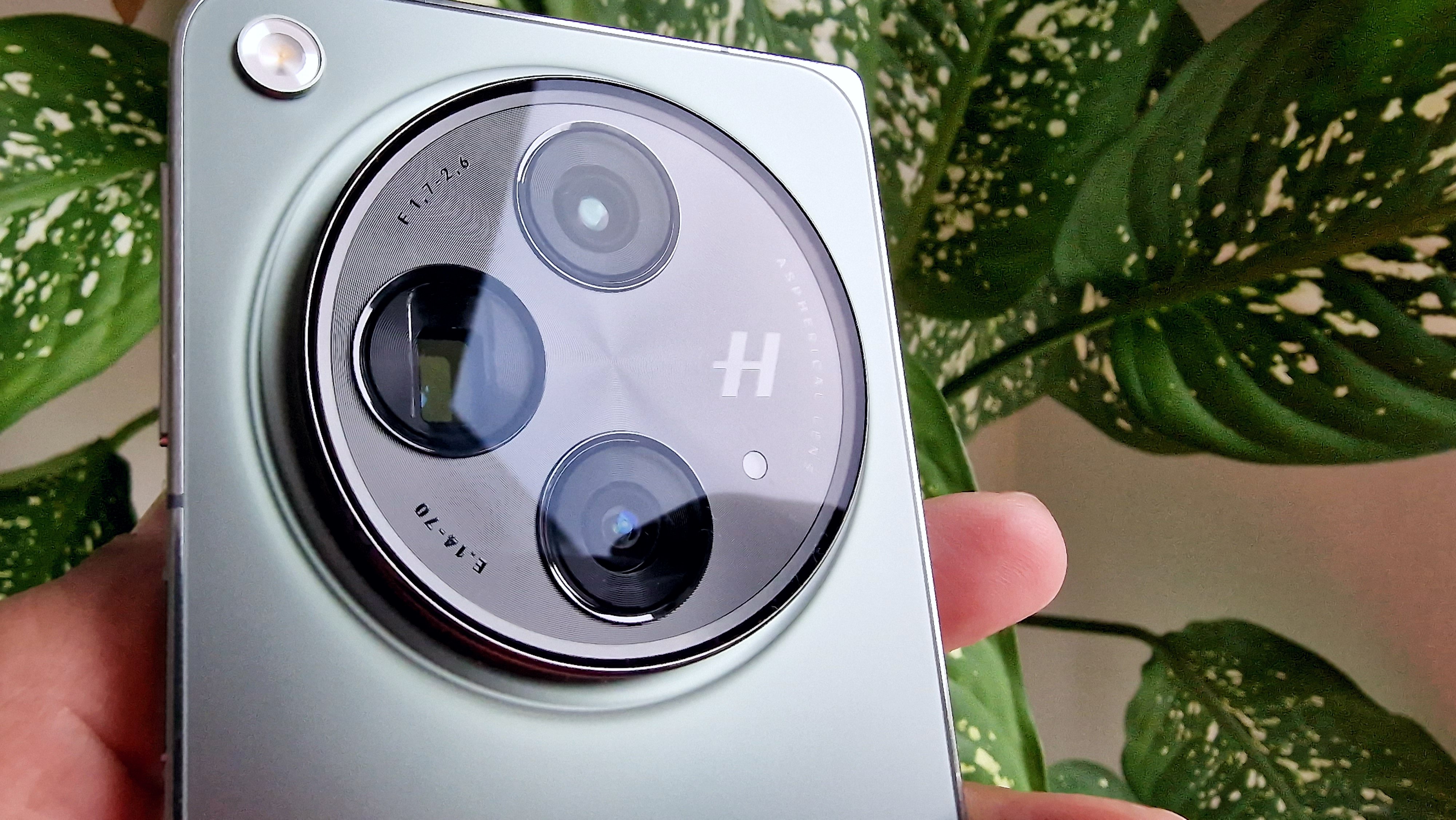


3. OnePlus Open
Our expert review:
Specifications
Reasons to buy
Reasons to avoid
The OnePlus Open gives us everything we want in a foldable phone that we weren't getting before. It has great cameras, especially for portraits and selfies. It also has the best design of any big foldable phone, especially if you're willing to pay a bit more for the OnePlus Open Apex edition, which comes in a Crimson Shadow Color and includes 1TB of storage inside.
In classic OnePlus fashion, the OnePlus Open is a flagship killer, so you get great specs, especially when it comes to the phone's performance and the great displays, inside and out. You also get a cool design, all for a lower price than most competitors. Don't be scared off by the phone's price tag, OnePlus is making it easy to get an even bigger discount if you have any phone to trade.
The OnePlus Open admittedly comes with some compromises that you won't find on a Samsung Galaxy Z Fold 7. It isn't water resistant, while Samsung's phone can take a dunk under water. Its also a little lighter on productivity and AI features, which the Galaxy Z Fold 7 has an abundance of.
That doesn't matter, because the OnePlus Open is built so well; while it's not really 'thin' compared to the competition, in day-to-day use, the OnePlus Open still feels perfect. If you want a tablet foldable phone for less, there's only one to consider.
Read our full OnePlus Open review
The best flip phone
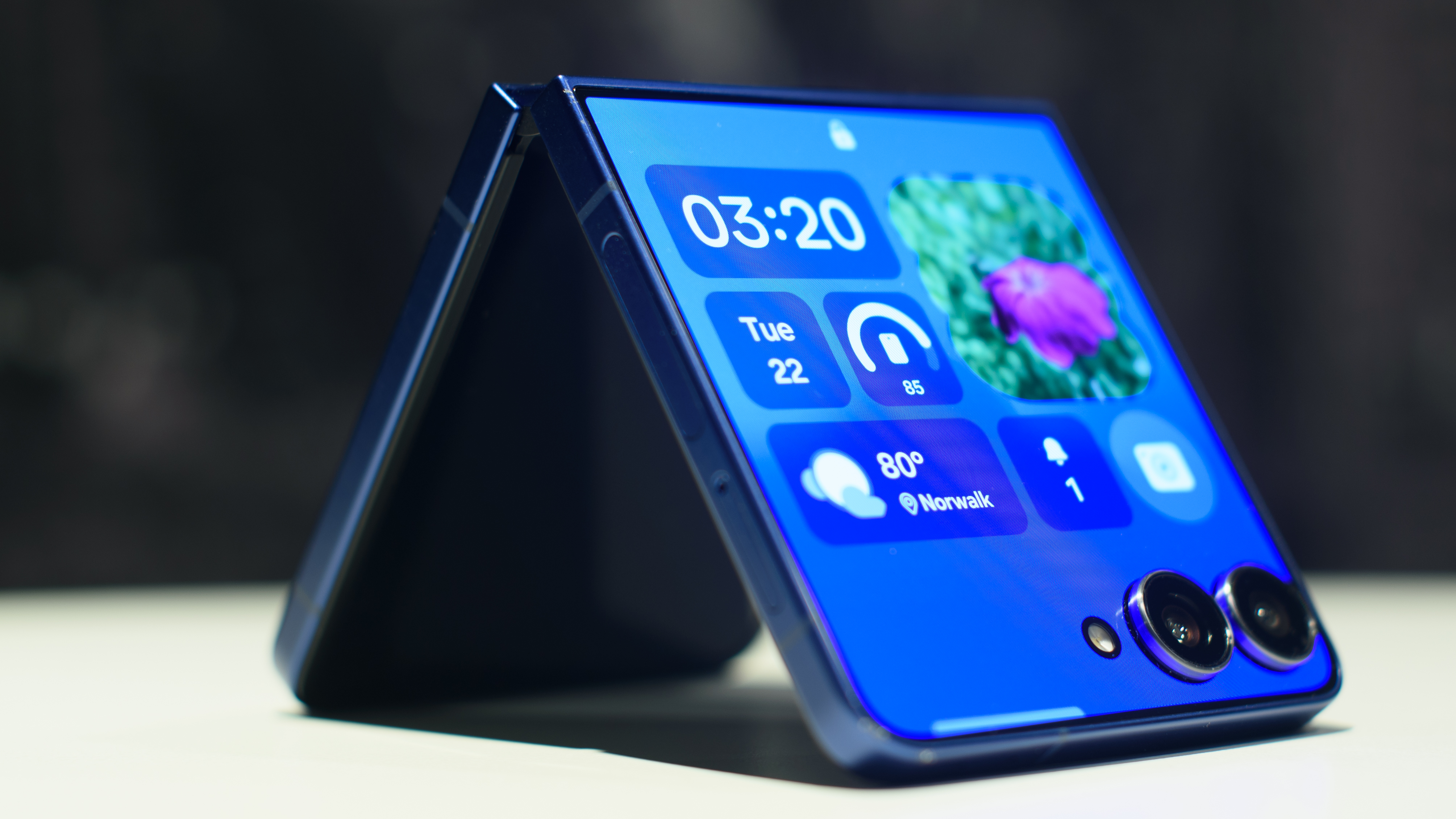
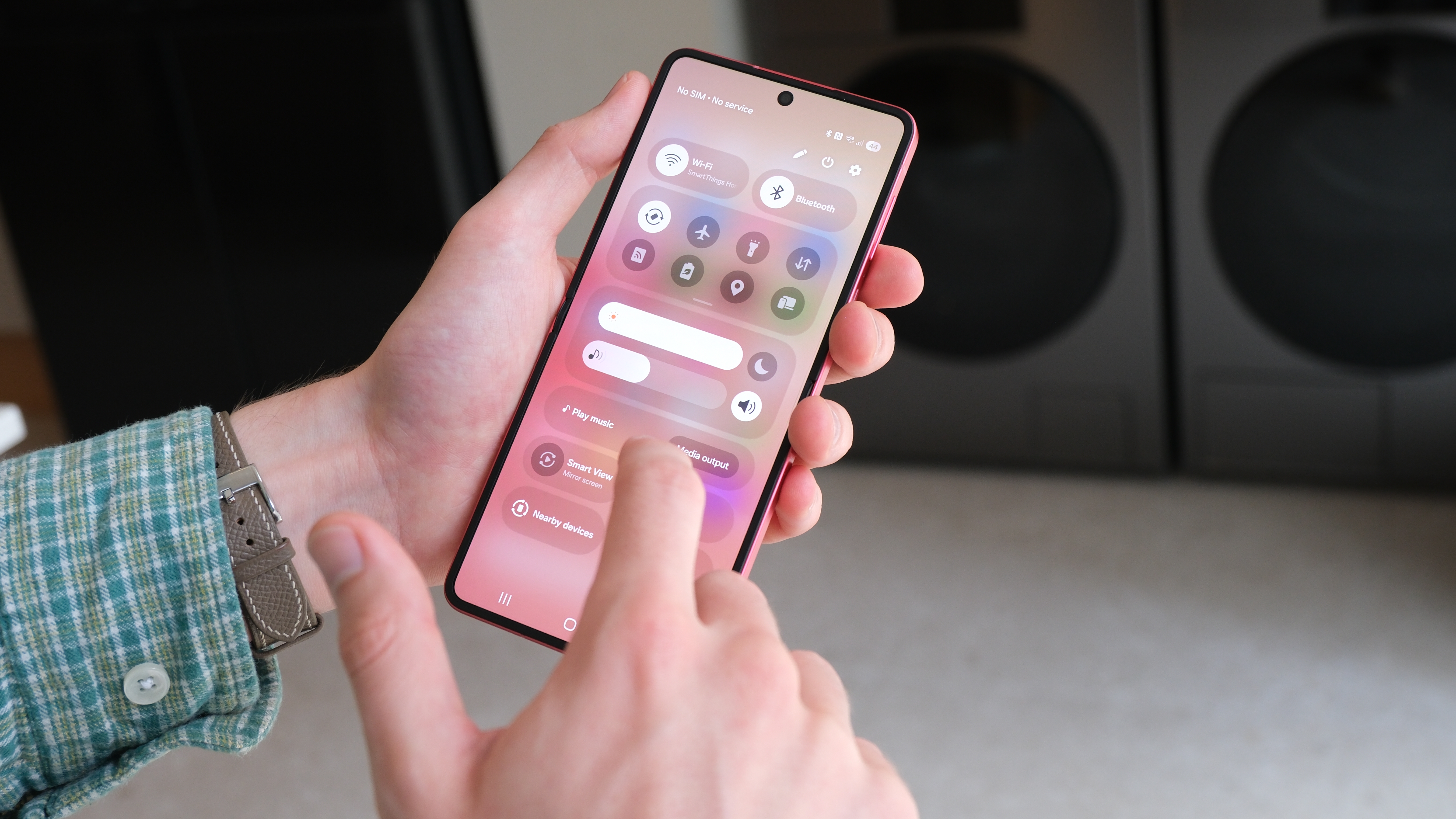
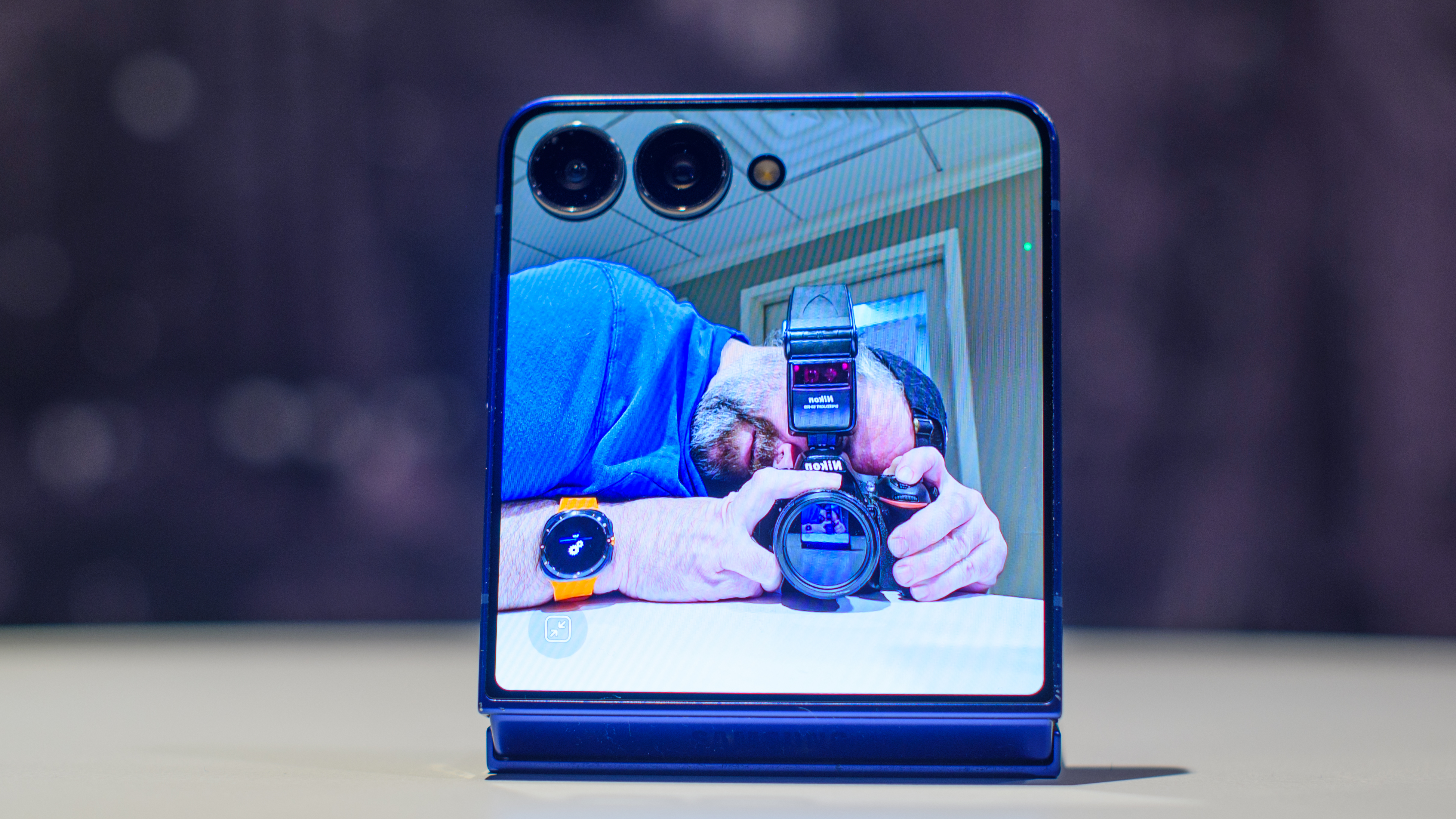
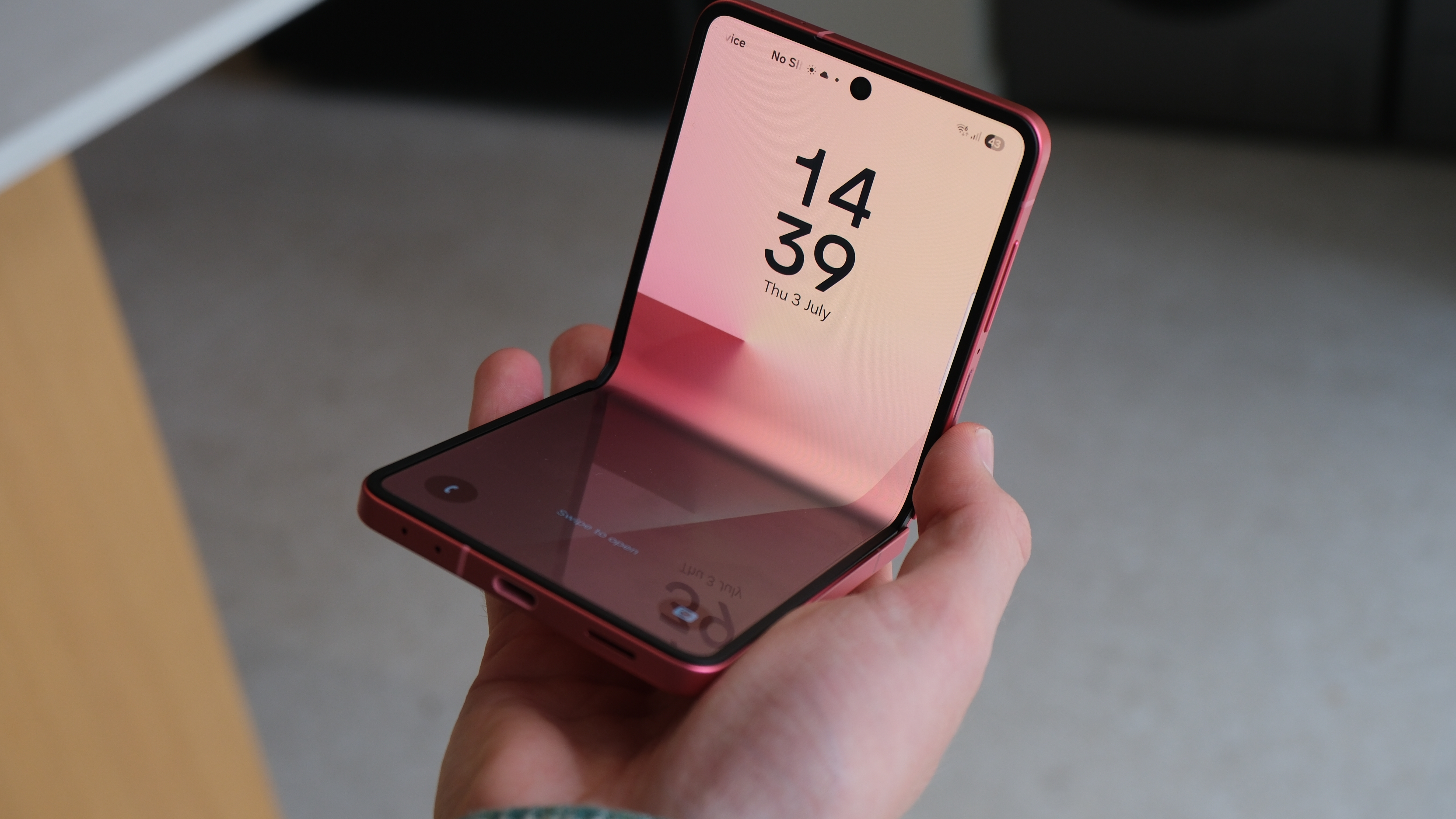
4. Samsung Galaxy Z Flip 7
Our expert review:
Specifications
Reasons to buy
Reasons to avoid
The Samsung Galaxy Z Flip 7 is, as you might expect, the best flip phone Samsung has ever made. As is the case with its big cousin, the Galaxy Z Fold 7, the Galaxy Z Flip 7 breaks the pattern of iterative upgrades, and stands toe-to-toe with competition from Motorola and imports from Xiaomi and Oppo.
The most noticeable of the phone's features is the true edge-to-edge cover display, meaning the phone now looks as remarkable closed as it does unfolded. As our Galaxy Z Flip 7 review notes, the cover display is large enough to be actually useful, and the crease on the inner screen is invisible in typical use.
It's loaded with even more AI than last year's model, with access to Samsung's own Bixby as well as Google Gemini, and comes pre-loaded with One UI 8, based on Android 16.
As ever, though, the Galaxy Z Flip 7's true strength is in its design and build quality. No other flip phone feels as solid or stays in position so rigidly when partially open, which makes setting the phone up to take photos or watch videos feel effortless. That cover screen has the thinnest bezel on any Galaxy phone, and the color options are vibrant and varied.
It's not a perfect phone – performance could be better, and battery life is just okay – but when it comes to flip phones, you won't find an experience that's more refined or more heavily loaded with features.
Read our full Samsung Galaxy Z Flip 7 review
The best cover display
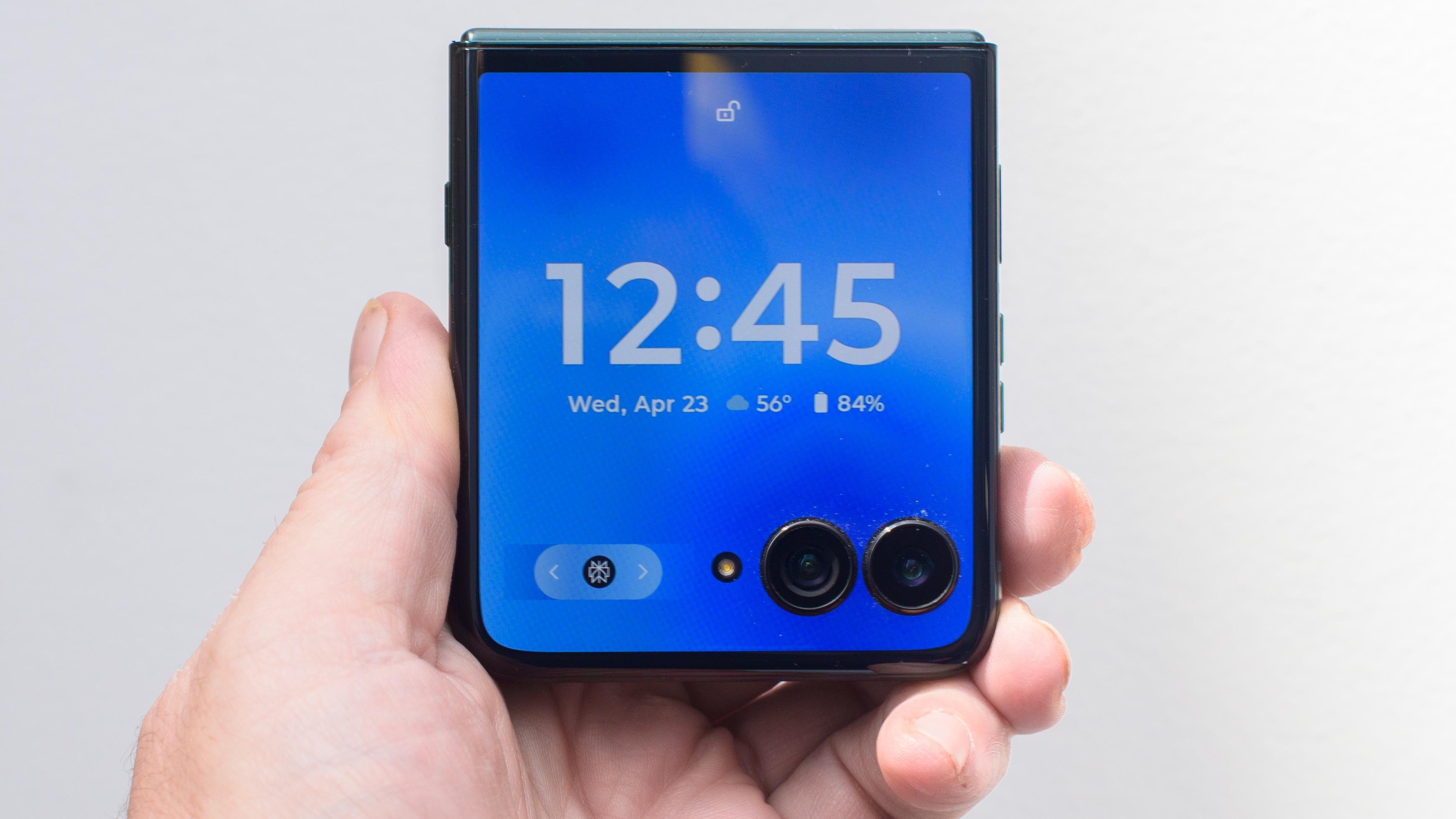

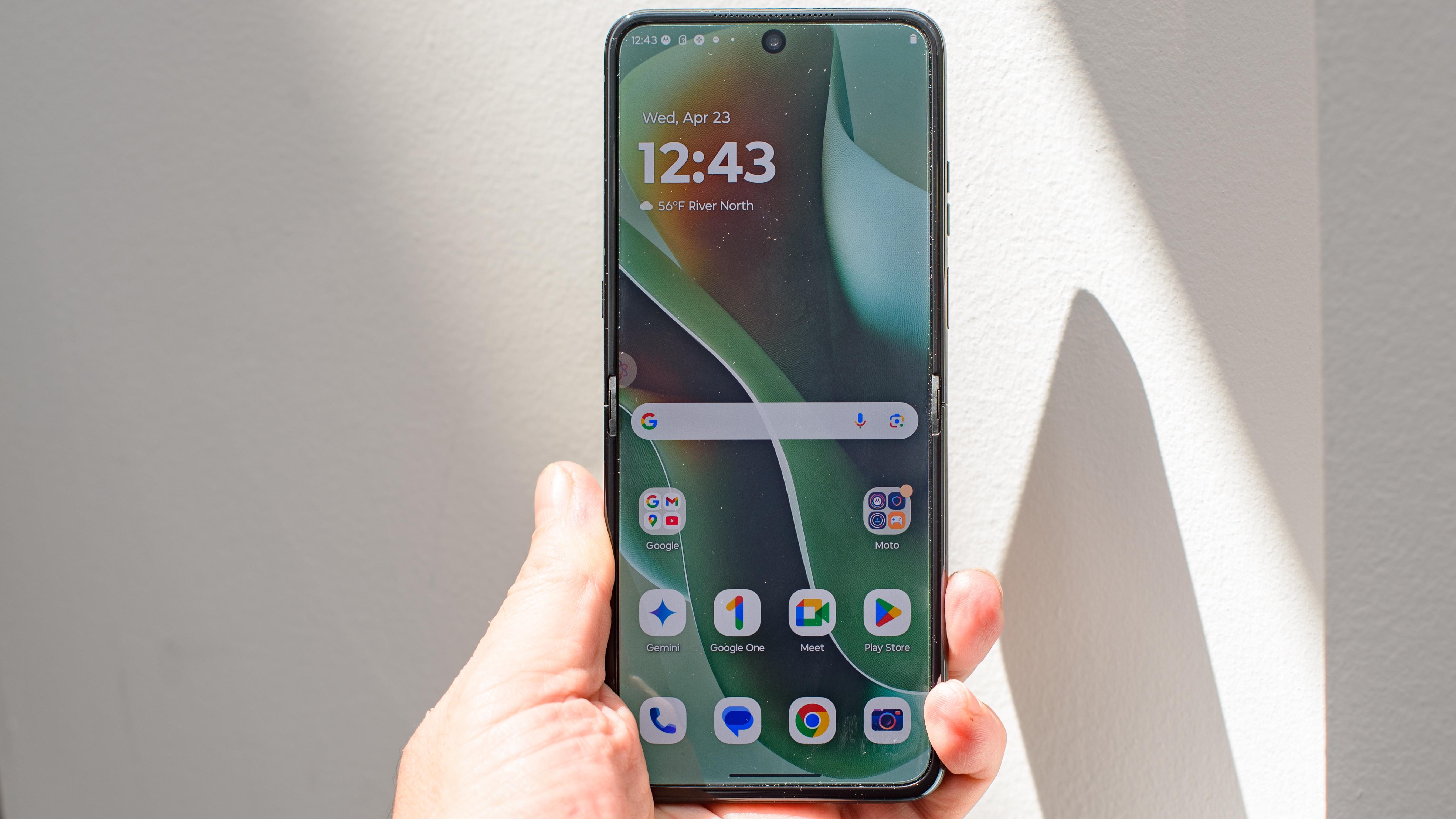

5. Motorola Razr Ultra 2025
Our expert review:
Specifications
Reasons to buy
Reasons to avoid
Of all the phones on this list, the Motorola Razr Ultra 2025 is the one most dedicated to standing out. Alongside several quirky color and material options, the Razr Ultra 2025 has a simply gorgeous cover display. It's almost as large as the Samsung Galaxy Z Flip 7's cover screen and has a higher resolution and peak brightness, making it easier to use the cover display outdoors. We were so impressed by the cover screen during testing that our review calls it "half the fun" of the phone.
This stylish flip phone is more than its cover display, though – the Motorola Razr Ultra 2025 is as impressive when it comes to performance as it is in its design. The phone is powered by the class-leading Qualcomm Snapdragon 8 Elite chipset and 16GB of RAM, which is more horsepower than the Galaxy Z Flip 7 gives you. As such, it scored full marks for performance in our review testing, and you can even game on the cover display (if you want to).
And how about those color options? The Razr Ultra 2025 is the only phone I've seen this year that has actual wood panelling as one of its aesthetic options – there's also an Alcantara fabric option and some vibrant Pantone-branded colors.
Like all Motorola phones, the Razr Ultra 2025 runs a near-stock version of Android with very little bloatware. It's a clean, intuitive experience, whether you find yourself leaning towards its excellent cover screen or (also wonderful) 7-inch inner display.
Read our full Motorola Razr Ultra 2025 review
The best import foldable

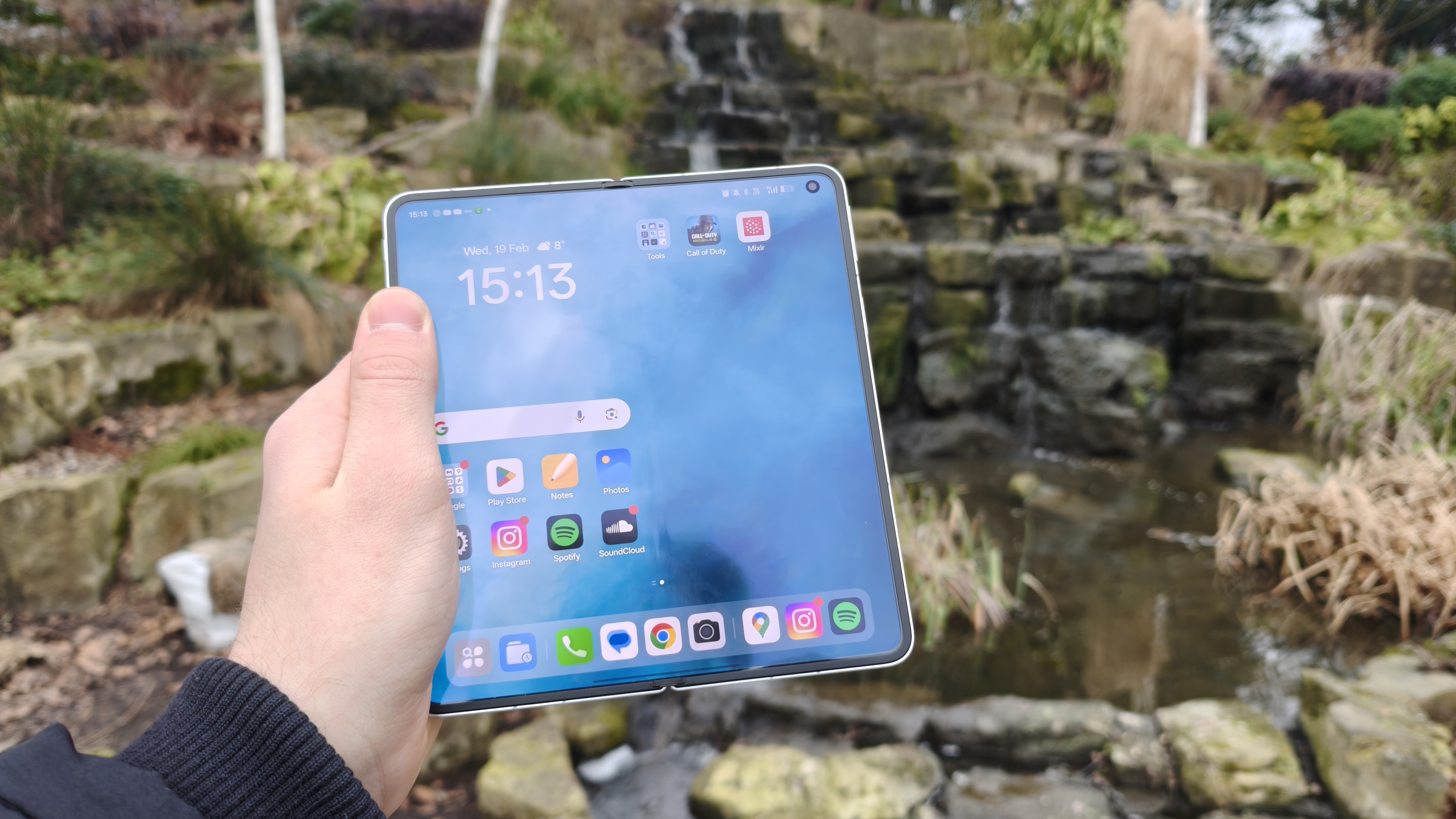
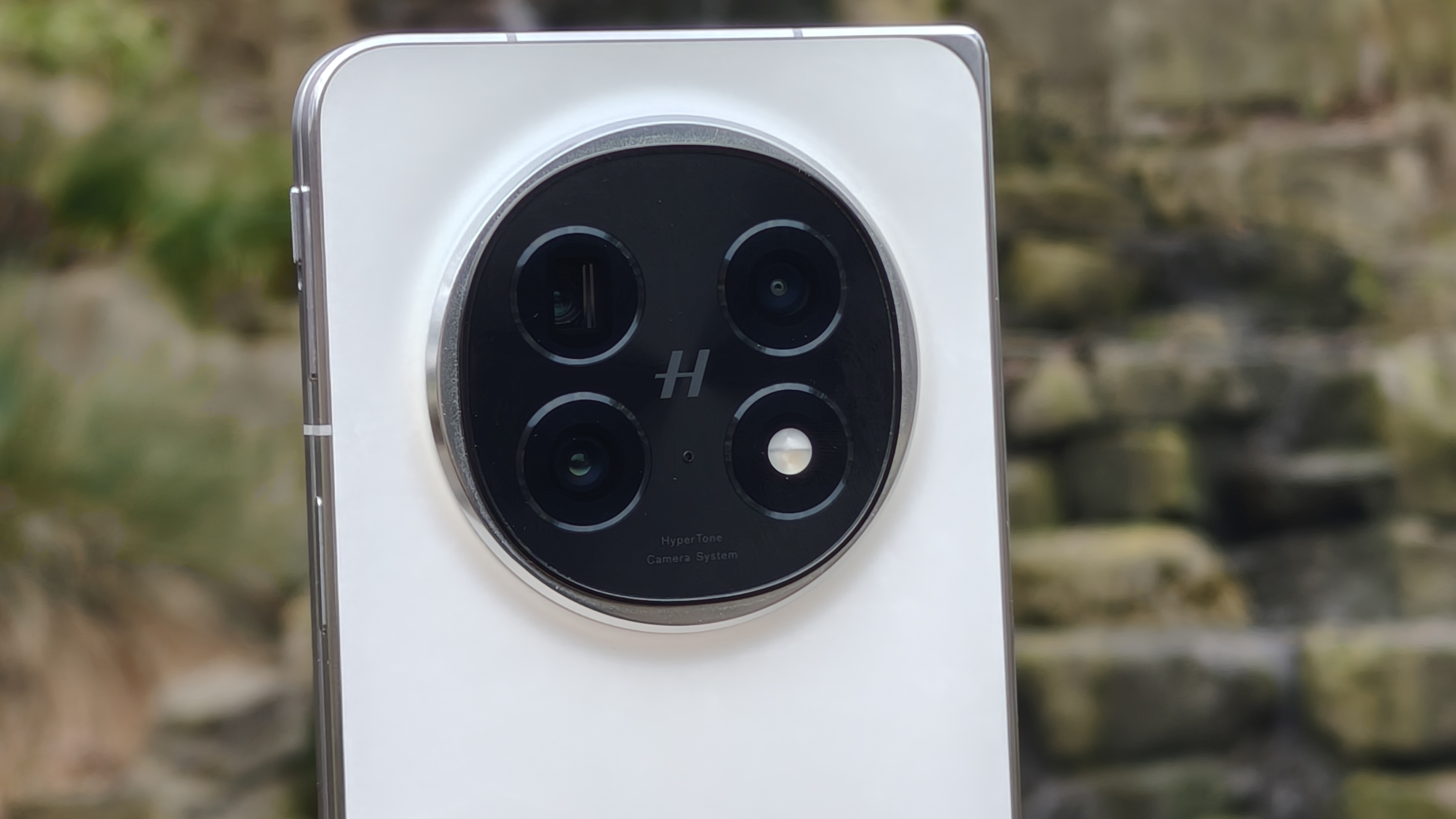
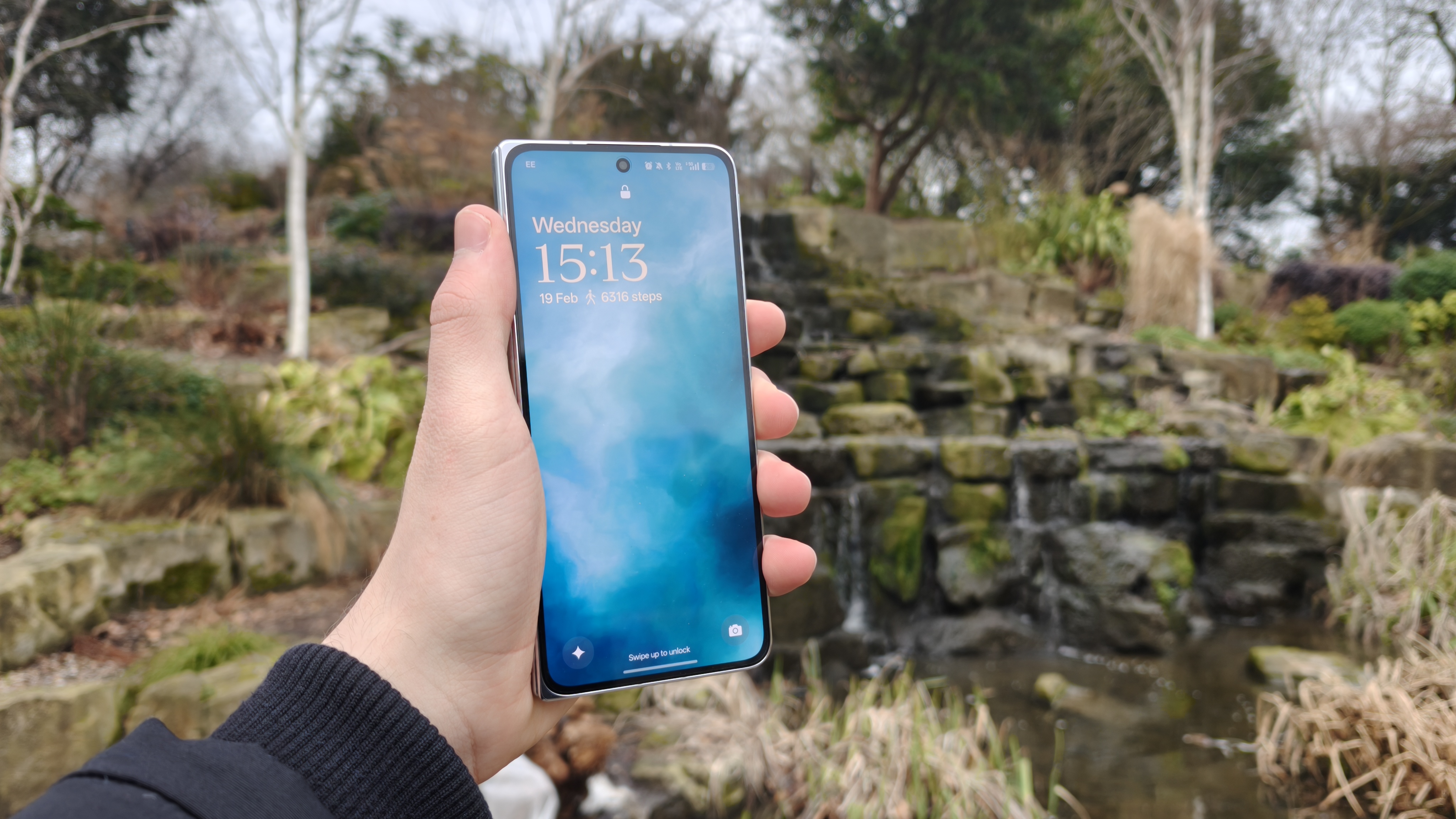
6. Oppo Find N5
Our expert review:
Specifications
Reasons to buy
Reasons to avoid
The Oppo Find N5 is a marvel of engineering and a generational step forwards for the folding phone category – unfortunately, it's also very hard to buy - it's totally absent from the US, UK, and Europe. It's coming to Australia, but we don't have official pricing yet. So, we won't include the Oppo Find N5 in our rankings, but we had to give it a mention thanks to its futuristic design and immense hardware power.
As our review liberally mentions, the Oppo Find N5 is the thinnest tablet foldable phone in the world, and the thinnest folding phone after the tri-fold Huawei Mate XT. It's just 4.21mm thin when unfolded, thinner than an iPad Pro, and 8.93mm folded, which is just barely thicker than an iPhone 16 Pro Max.
While testing the Oppo Find N5 for our review, I found that the phone basically felt like a normal slab phone while folded, and packs enough hardware power to rival the best Android phones for multitasking on its large inner display. I was impressed by the speed of the Snapdragon 8 Elite chipset and the longevity of the 5,600mAh battery, all of which weighs in at about as much as a typical slab phone.
Oppo wasn't content to just make the world's thinnest book-style foldable, and so equipped the Find N5 with the largest displays found on a phone of this type. With an immersive 8.12-inch inner display and 6.62-inch cover screen, the Oppo Find N5 makes any video, article, or game look fantastic, building on the great screens found on the OnePlus Open (the previous-generation Find N3 in all but name). It's also water resistant, with a titanium hinge that's far more durable than prior models.
There are some drawbacks –I wasn't too impressed with the Find N5's cameras, there's no rated dust resistance, and there are a few software bugs to iron out – but the "wow" factor of holding such a powerful, beautiful, slim device never fades. It's just a shame the Find N5 isn't coming to more territories.
Read our full Oppo Find N5 review
How to choose the best foldable phone for you
First decide if you want a foldable phone that opens into a larger tablet display, or a foldable phone that folds into a smaller clamshell device. We have picks for both options.
A tablet foldable phone gives you an outer display that is a little smaller than a normal smartphone, though phone makers are trending towards wider and larger cover screens. The inner display on a modern tablet-style foldable is typically between 7 and 8 inches.
A flip foldable phone gives you an inner display that is larger than most smartphones. The Samsung Galaxy Z Flip 7 has a 7-inch foldable display, while an iPhone 16 Pro Max has a 6.7-inch display.
FAQs
Will Apple make a folding phone?
Apple hasn't given us any clues as to whether it's working on a folding phone – but unlike Samsung and Google, Apple rarely announces products until they're almost ready to hit shelves. We've certainly heard plenty of rumors about a possible folding iPhone, and it seems likely that Apple would want to be part of the folding phone market, but we can't say for sure.
How do foldable phones work?
Foldable phones are, as the name suggests, defined by their folding screens. Most folding phones use a layer of flexible glass with a preinstalled plastic screen protector for their inner folding screen. A hinge sits in the middle of the phone, allowing the entire construction to bend in half, and magnets in the frame keep the phone firmly closed.
Tablet-style folding phones have hinges that run vertically through the middle of the phone, while flip phones have hinges that run horizontally through the middle of the phone. Otherwise, the screen and hinge technology is pretty similar between each type of foldable.
The internal components of folding phones are split between the two halves of the device – including the battery. This causes some inefficiency that means folding phones can offer less battery life than slab phones of equivalent capacity.
Are foldable phones durable?
Folding phones are generally not as durable as slab phones. The plastic screen protector that covers the flexible glass inner display of a folding phone is typically soft enough to be scratched or dented pretty easily, with some models even warning against pressing too hard with a fingernail. It's also important to avoid pressing too hard on the crease in the middle of a foldable display to avoid damaging the hinges.
Some folding phones have IP dust and water resistance ratings, but only the Google Pixel 10 Pro Fold has the IP68 rating that premium slab phones come with as standard. This means that most foldable phones are less resistant to dust and water than conventional slab handsets.
What is the cheapest foldable phone?
Folding phones are, typically, much more expensive than slab phones, but there are some reasonably-priced options.
The cheapest folding phone on the market is the Motorola Razr 2025 (known in some markets as the Motorola Razr 60), which comes in at $699.99 / £799.99 / AU$1,199.
Additionally, Samsung launched its first FE-branded folding phone in 2025, the Samsung Galaxy Z Flip 7 FE, which can be had for $899 / £849 / AU$1,499.
As for tablet-style folding phones, the Google Pixel 10 Pro Fold is the cheaper of the two current-gen options in the US, at a still-hefty price of $1,799 / £1,749 / AU$2,699. In the UK, however, the Honor Magic V5 comes in at £1,699, and is frequently on sale for much less.
Of course, older, refurbished, and second-hand options can save you a fair bit of money, just be sure to check out the warranty coverage and other terms and conditions before making a purchase.
Which phone makers make foldable phones?
In the US, your options for folding phones come down to models from Samsung, Google, OnePlus, and Motorola.
In other regions, Chinese phone makers like Honor, Oppo, and Xiaomi offer various flip and tablet-style folding phones, which often come in at slightly lower price points than their Western counterparts.
Should I buy a foldable phone?
Whether a folding phone is right for you depends on a few factors. As mentioned, folding phones are typically more expensive than a slab phone of equivalent capability, but offer a more versatile and more powerful experience due to their dual-screened design.
If you use your phone for multitasking, like running several apps on screen at once, or like watching videos or gaming on a larger mobile screen, then a tablet-style folding phone could be a worthwhile investment.
If you value portability, care about flair, or want the option of using a smaller screen alongside a normal large smartphone display, then a flip phone could be the right pick for you.
How we test the best foldable phones
We've only included phones on this list that we've thoroughly tested, and our testing regiment is deep and detailed. We test every aspect of folding phones that you might use from day-to-day, then we dive deeper to discover all of the hidden features.
We test all phones for battery life and charging, speed and performance, and especially for camera capabilities. We make sure that phones deliver on their manufacturer's promise. If it says a phone can charge in 30 minutes, we break out the stopwatch.
For folding phones in particular, we make sure to spend plenty of time using both the cover display and inner folding screen. We test the hinge action for reliability and sturdiness, and inspect the screen for any creases, watching carefully to see how the display holds up over time. We also test any foldable-specific software features, like multitasking abilities or unique camera modes
Folding phones are more expensive than slab phones, so we make sure that the handset delivers what we'd expect for the cost. Design and build quality matter for a phone with so many moving parts, so we're always careful to notice the finer details of a folding phone's construction.
Once we're done, we don't stop. We keep updating our reviews as we learn more, and as the phones are updated. Our reviews are always fresh, so check back before you buy to make sure you're getting the latest opinion on the best phones you can buy.
TechRadar foldable phones coverage
Buying guides
Reviews
- Samsung Galaxy Z Fold 7 review
- Samsung Galaxy Z Flip 7 review
- Motorola Razr Ultra 2025 review
- Google Pixel 10 Pro Fold review
- OnePlus Open review
- Oppo Find N5 review
Explainers
- How to transfer data to a new Samsung Galaxy phone
- How to use Pixel Studio to make AI images on a Google Pixel phone
- How to connect your Android phone to a Windows PC using Phone Link
- How to erase an Android phone
First-hand experience
- I switched to a folding phone – and I love it so much that I’m never going back
- I review regular phones for a living, but switching to a foldable has changed the way I use Android
- I thought the tri-folding Huawei Mate XT was a gimmick, but then I held it
Sign up for breaking news, reviews, opinion, top tech deals, and more.

Jamie is a Mobile Computing Staff Writer for TechRadar, responsible for covering phones and tablets. A lifelong tech-obsessive, Jamie began his writing career as a music blogger before studying journalism at Goldsmiths College, and joined TechRadar in 2024. He thinks the iPhone 5S is the greatest phone of all time, but is currently an Android user.
As well as reporting on the latest in mobile hardware, software, and industry developments, Jamie specialises in features and long-form pieces that dive into the latest phone and tablet trends. He can also be found writing for the site's Audio and Streaming sections from time to time, or behind the decks as a DJ at local venues around London.
- Philip BerneSenior Editor, Mobile Reviews & Buying Guides